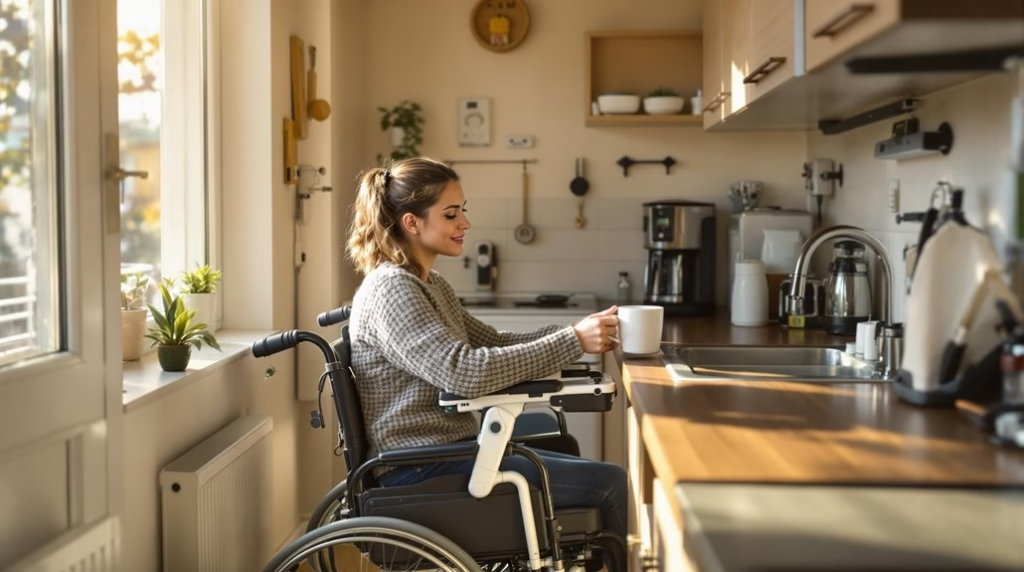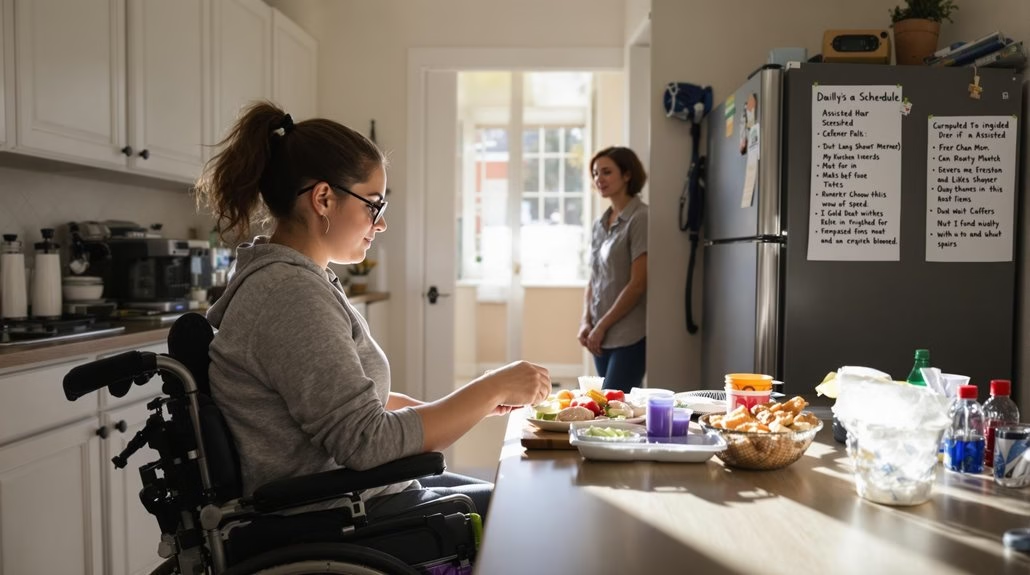You can live alone with cerebral palsy if you have the right support systems and adaptations in place. Your success depends on your individual capabilities, mobility level, and access to necessary resources. While some people might need minimal assistance, others may require more extensive support with daily tasks. By evaluating your needs and implementing proper home modifications, safety features, and support networks, you’ll discover the path to achieving independent living that works for you.
Understanding Independence Levels With Cerebral Palsy
While cerebral palsy affects each person differently, understanding one’s independence level is essential for determining if living alone is feasible.
You’ll need to assess your mobility, self-care abilities, and cognitive function to set realistic personal goals for independent living.
Your independence challenges may include tasks like dressing, preparing meals, or managing household chores.
Daily life with cerebral palsy presents unique hurdles, from managing personal care routines to tackling essential household responsibilities independently.
Consider how well you can perform daily activities without assistance, including personal hygiene, taking medications, and maintaining your living space.
You might need adaptive equipment or modifications to help overcome specific limitations.
It’s important to evaluate your strength, balance, and coordination honestly.
Working with healthcare providers and occupational therapists can help you identify areas where you excel and where you’ll need support, allowing you to make informed decisions about living independently.
Medicaid home care services can provide professional medical and personal care assistance tailored to your specific needs while maintaining your independence at home.
Assessing Individual Capabilities and Needs
To build on understanding your independence level, you’ll need to conduct a thorough self-assessment of your specific capabilities and daily needs.
Start by evaluating your mobility, self-care abilities, and cognitive functions through personalized assessments with healthcare professionals.
Consider your strengths in areas like meal preparation, personal hygiene, household management, and transportation.
Capability evaluations should also examine your ability to handle emergencies, manage medications, and maintain social connections.
Document both what you can do independently and where you might need assistance.
Remember that identifying areas where you need support isn’t a weakness – it’s an essential step in creating a realistic plan for independent living.
This honest assessment will help you determine which adaptive equipment, home modifications, or support services you’ll need to live safely on your own.
Similar to Parkinson’s care assessments, a 3-step care process can help evaluate your readiness for independent living through consultations and in-home evaluations.
Essential Home Modifications and Safety Features
Making your home safe and accessible requires strategic modifications tailored to your specific needs with cerebral palsy. Focus on installing grab bars in bathrooms, wide doorways for mobility devices, and non-slip flooring throughout your living space.
You’ll want to guarantee countertops and cabinets are at comfortable heights for easy reach.
Vital safety features include emergency alert systems, proper lighting in all areas, and secure handrails along stairs and hallways.
Consider accessible design elements like lever-style door handles, roll-under sinks, and motion-sensor faucets to enhance independence. If you use a wheelchair, ramps and lowered light switches become essential additions.
Remember to keep pathways clear and organize your living space to minimize the risk of falls while maximizing your ability to navigate independently.
Fall prevention strategies are crucial for maintaining safety and independence while living alone with cerebral palsy.
Support Systems and Available Resources
Beyond physical home adaptations, building a robust support network forms the foundation for successful independent living with cerebral palsy.
A strong support system empowers those with cerebral palsy to live independently and thrive in their communities.
You’ll find numerous community resources and organizations dedicated to helping you maintain your independence while ensuring you have the support you need.
- Connect with local disability advocacy groups that can link you to essential services, including transportation assistance, meal delivery, and home care support.
- Join peer support groups where you can share experiences, get advice, and build friendships with others who understand your journey firsthand.
- Utilize case management services through healthcare providers or social services to coordinate your care needs and access available financial assistance programs.
Consider scheduling a personalized phone consultation to discuss your specific needs and develop a customized care plan that promotes your independence.
Building Life Skills for Independent Living
While living independently requires various skills, developing practical abilities for daily life is essential for anyone with cerebral palsy. You’ll need to focus on mastering basic tasks like personal hygiene, meal preparation, and household management.
Start by breaking down complex activities into smaller, manageable steps and practice them regularly.
Key life skills include managing your finances, scheduling appointments, and organizing transportation. You can work with occupational therapists to develop strategies for handling daily tasks efficiently.
Learning to use adaptive equipment and technology will also enhance your independence.
Consider taking classes or workshops specifically designed for independent living skills. These programs often cover important topics like safety awareness, emergency preparedness, and social interaction.
Remember to set realistic goals and celebrate your progress as you build confidence in your abilities.
Skilled home healthcare services can provide additional support and training to help you develop independence while ensuring safety and comfort.
Technology and Adaptive Equipment Solutions
Modern technology and adaptive equipment have revolutionized independent living for people with cerebral palsy. You’ll find numerous assistive devices that can help overcome daily challenges and enhance independence. Smart home technology has made controlling your environment easier than ever, from voice-activated lighting to automated door systems.
- Mobility solutions like advanced wheelchairs, lift systems, and transfer aids can help you move safely throughout your home and maintain your independence.
- Communication devices with speech-generating capabilities and eye-tracking technology guarantee you can express yourself clearly and control various aspects of your environment.
- Smart home features allow you to manage thermostats, security systems, and appliances through voice commands or mobile apps, reducing the need for physical manipulation.
These technological solutions continue to evolve, making independent living increasingly accessible and manageable.
Financial Planning and Government Assistance
Living independently with cerebral palsy requires careful financial planning and understanding of available support systems.
You’ll need to explore various financial resources, including Social Security Disability Insurance (SSDI), Supplemental Security Income (SSI), and Medicaid benefits. These programs can provide essential income and healthcare coverage.
Develop effective budgeting strategies to manage your living expenses, medical costs, and adaptive equipment needs.
Consider working with a financial advisor who specializes in disability planning to create a sustainable long-term financial plan.
You may also qualify for housing assistance programs, vocational rehabilitation services, and tax deductions specific to disability-related expenses.
Don’t forget to investigate local non-profit organizations and advocacy groups that offer grants or financial assistance for home modifications and essential equipment.
Many states also provide additional support programs to help maintain your independence.
Conclusion
Living independently with cerebral palsy is absolutely possible, and many people are doing it successfully right now. Picture a cozy apartment or home where someone with CP can move freely, using special equipment and smart home features that make daily tasks easier. Just like building a strong support network of friends and family, creating the right living space takes careful planning and the right tools.
You’re not alone on this journey. With proper preparation and support, people with CP can enjoy the freedom and pride that comes with having their own space. Think of it as building a bridge to independence – one step at a time, with helping hands along the way.
The key is finding the right balance of support services, adaptive technologies, and daily living strategies that work for your unique situation. Whether it’s installing grab bars in the bathroom or using voice-controlled devices, there are many creative solutions available.
At Focus Family Care, we understand that every person’s path to independence is different. We’re here to help you or your loved one create a safe, comfortable living environment that promotes both independence and peace of mind.
If you or a loved one need help, don’t wait. Reach out to Focus Family Care today at (561) 693-1311 or email us at info@focusfamilycare.com.





